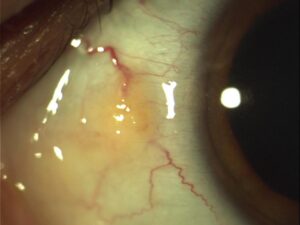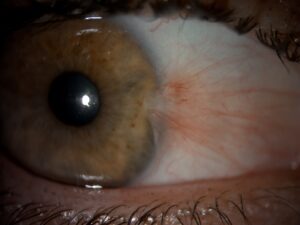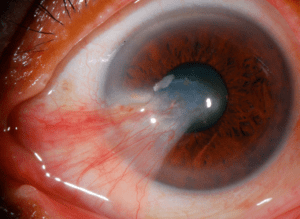Pterygia: “Surfer’s eye”
Pterygia (singular: pterygium) are growths of benign fibrovascular tissue that develop due to UV exposure. They begin on the whites of the eye (the conjunctiva) as pingueculae and generally give a yellowing or slightly red appearance. Some pingueculae will never progress to become pterygia – especially if you maintain good UV protection. However, if they do continue to grow they will encroach onto the cornea (the clear surface overlying the iris) and are now called pterygia.

Pinguecula

Mild Pterygia

Advanced Pterygia
Who is at risk?
Everyone! They can develop in anyone but you are at much greater risk if you live in sunnier areas, and spend a lot of time outdoors or at the beach.
Surfers have increased risk as the light that reflects from the surface of the water converges, which further concentrates the UV light to your eyes.
How does a pterygia or pinguecula affect a sufferer?
- Sometimes they are mild and haven’t become pterygia yet, some people will never be aware of them
- Cosmetically, the whites of your eyes can yellow or become redder. And when they grow onto the cornea they generally appear white so are a little more noticeable against the iris colour. They also can appear raised.
- Others will experience dry, itchy, red and/or watery eyes. These symptoms may fluctuate throughout the year, or when partaking in certain activities.
- If the tissue grows onto the cornea (pterygia), dryness and irritation is likely to increase. Vision may start to blur and there may be a heightened sensitivity to glare. This is because the pterygia pulls on and can change the shape of the cornea and thus can change your prescription.
- Some people will become intolerant to contact lens wear.
What can be done about it?
- Palliative lubricant drops help a lot with dealing with the symptoms
- If it does become particularly inflamed then a short course of steroid drops may be used if recommended by your Optometrist.
- Updating your glasses/CL prescription to include the astigmatic correction may be useful.
- Surgery to remove the tissue by an Ophthalmic surgeon that specialises in the anterior eye.
Who needs surgery?
If the patient:
- Becomes significantly symptomatic (and the above treatments aren’t helping enough)
- Has recurrent episodes of irritation and inflammation
- Is concerned about the cosmetic appearance
- Is no longer able to wear CLs
Or if the pterygia:
- Is encroaching onto the cornea a lot and growing
- Is causing significant changes to the patient’s vision or prescription
It is important to note that pterygia can grow back after surgery.
What can you do to avoid them?
When you venture outside during the day, wear sunglasses and a hat to prevent UV light from getting to your eyes – particularly at higher UV periods of the day. Most importantly – encourage this behaviour with children!
Avoid rubbing your eyes. If the eyes are feeling particularly itchy then use a cold face cloth to minimise the itch or use eye drops.
Related Articles

Sustainability in Small Business
Small businesses have a wonderful platform to be thought leaders and influencers in communities, and I believe have a social responsibility to make the environment a key factor in decision making.

Myopia Intervention
Myopia, known as short-sightedness, is a condition that results in blurred distance vision. Unfortunately, rates of myopia in children are steadily on the rise. This

Myopia Epidemic
Myopia, known as short-sightedness, is a condition that results in blurred distance vision. This occurs due to refractive error; a consequence of an elongated eyeball




